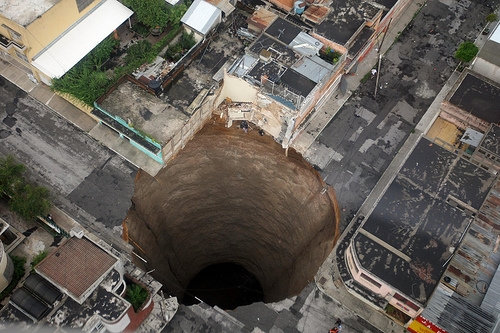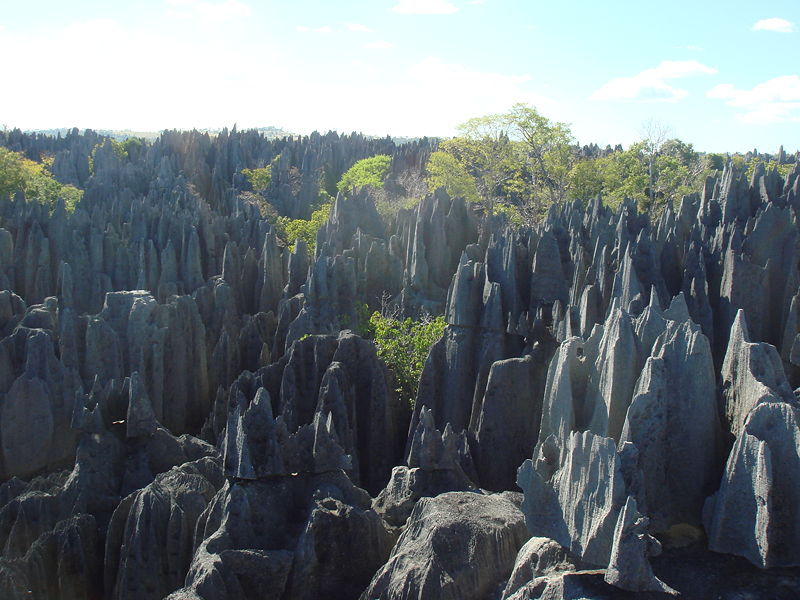2 June 2010
(UPDATED*) Sinkholes: A chronic geohazard
Posted by Michael McFadden

This sinkhole swallowed a city intersection in Guatemala City on 31 May 2010 in the wake of tropical storm Agatha (Credit: Guatemalan Government)
Guatemala has been struck by the full wrath of nature in the last week – first, the volcano Pacaya erupted, killing at least three people, and blanketing the region in ash. Soon after, tropical storm Agatha passed through the country near the Guatemala-Mexico border killing at least 152 people. Heavy rainfalls led to widespread flooding and the formation of a dramatic sight – a sinkhole over 20 meters (65.6 feet) in diameter that swallowed an entire intersection in Guatemala City.
(*UPDATE, 3 June 2010: Some geologists are now referring to the giant Guatemalan hole as a “piping feature” instead of a sinkhole. Read more on Discovery News.)
(*UPDATE, 16 June 2010: When we asked Doctor about the terminology issue, he told us: “The feature is most certainly a sinkhole, it is just a different type of sinkhole than the kind that is normally associated with karst terrains. This type of feature is a “cover-collapse” sinkhole, or “dropout” sinkhole. The original void may have resulted from the piping of volcanic sediment deposits in the subsurface, but it is a sinkhole nonetheless.)
To find out how sinkholes work, what role humans may be playing in their formation, and how much damage sinkholes really can do, Geohazards blog asked for some explanations from Daniel Doctor, a geologist with the United States Geological Survey. Here’s what we learned:
Q: The first obvious question is – where does all of the land go?
A: It goes into a pre-existing void in the subsurface. Most commonly, those dramatic sinkholes that have nice round expressions and steep sides are what we call cover-collapse sinkholes. That is, beneath some part of the overlying land surface, there’s a void, and the cover is either unconsolidated weathered rock or some sediment that’s been deposited on top of rock, with a void that’s developed underneath it.
Q: What causes sinkholes? How do they form?
A: When we talk about a natural sinkhole that doesn’t seem to have been induced by any kind of human activity, we most typically talk about karst terrain.
Karst is a term applied to landscapes that show features like sinkholes, caves, springs and sinking streams. These all arise from the flow of water through soluble bedrock. When I say soluble, that is, it dissolves naturally in the water to create a pipe network through the rock. You may have seen dramatic photos of karst terrains in areas like China, Taiwan, or Madagascar where they have these knife-life spires of limestone sticking up into the air.
Think of it like soil covering a bedrock surface that is [often] highly irregular. What happens is: At the boundary between the soil (a.k.a. sediment) and the rock, you often have water that can run rather rapidly and that erodes out the sediment at the contact between the sediment and the rock.
Whenever you get pipes naturally forming in sediment to varying degrees and varying sizes, you get the potential to create sinkholes, because it’s essentially creating voids in the subsurface.
Q: How quickly can this process happen?
A: The timescale is very, very variable – anywhere from overnight to hundreds, thousands, maybe millions of years in the case of some natural karst terrains.
I read about a woman in Florida who said she was out gardening in her backyard. She had a little enclosed garden, smaller than the size of her house She was gardening, and the next thing she knew the ground collapsed underneath her, and she was stuck in an 2.4 m (8 ft) deep hole. She had to call for help; she had no way to climb out of the hole. Eventually somebody walked by and heard her cries and called the fire department and they came and got her out. So, [it can happen] very quickly in some cases.
In other cases you can observe over time what looks like a small depression in your front yard progressively open up and get larger and larger. There are cases in Texas where they’ve been slowly observing their backyards and houses erode away. It’s a cause of great consternation for people who know it’s sort of an impending, creeping, chronic disaster.
Q: How big, or small, can sinkholes be?
A: On the very smallest scale, something you could step in is what you kind of want to be concerned about. That’s damaging to you if you’re walking across a landscape and you step in a hole. It’s more damaging, though, to livestock and large animals.
On the large end I know of large collapse features in China and in Mexico that are a hundred meters in diameter.
Q: How often do big sinkholes, like the one in Guatemala, occur?
A: These very large sinkhole collapses are rare events in natural settings. They’ve become more frequent events in human settlements because we do a lot in the subsurface. We do disturb the subsurface quite a bit.
Q: What role might people be playing in causing sinkholes?
A: Number one I would say is [poorly] routing storm water drainage when you’re in a karst terrain. It is a big problem with road run-off, stuff like that.
[Another way is through] failing urban infrastructure for water conveyance; either bringing water to people’s homes or taking away sewage or storm run-off.
If a water main breaks, and the gushing water that’s coming out of the pipe begins to erode away the soil in the subsurface, you have the potential to create a sinkhole because very quickly you’ve created a void in the sediment in the subsurface.
Very often we see this after heavy rains, not only in karst terrains, but in and around cities with old aging sewer lines, like Washington D.C. for example.
They’re not in areas where you would expect to have natural sinkholes. They’re man-made in a sense because of the failing urban conveyance of water in the subsurface through pipes that age and break open. And when that water leaks out of the pipes, it finds its own way through the soil and erodes the soil. As it goes, it leaves behind voids that can then potentially collapse.
Q: How big of a problem are sinkholes?
A: I like to use the word chronic when I talk about sinkholes because in society we tend to focus on those acute disasters – the ones that hit quickly and cause a lot of damage in a very short amount of time, and affect a lot of people dramatically and in a devastating way. Whereas [the underground erosion that leads to] sinkholes in general tend[s] to be out there on the landscape all the time, in isolated places. We hear of them in news flashes – they’ve affected maybe a few people, maybe a city, not a lot of death and destruction. But it’s chronic, it’s there all the time.
– Colin Schultz, AGU science writer



 GeoSpace is a blog on Earth and space science, managed by AGU’s Public Information staff. The blog features posts by AGU writers and guest contributors on all sorts of relevant science topics, but with a focus on new research and geo and space sciences-related stories that are currently in the news.
GeoSpace is a blog on Earth and space science, managed by AGU’s Public Information staff. The blog features posts by AGU writers and guest contributors on all sorts of relevant science topics, but with a focus on new research and geo and space sciences-related stories that are currently in the news.
[…] wrote up a quick Question & Answer with a USGS geologist, Daniel Doctor, to try to answer some of the fundamental questions about […]
[…] a recent AGU Geohazards blog, a USGS expert on sinkholes explains how sinkholes form, where the material goes, and the role that […]